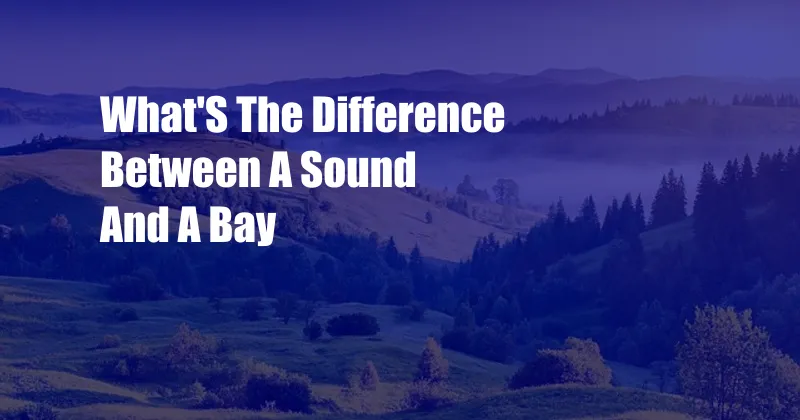
What’s the Difference Between a Sound and a Bay?
In the realm of coastal geography, the terms “sound” and “bay” are often used interchangeably, leading to some confusion. However, these two water bodies have distinct characteristics that set them apart. Understanding these differences is crucial for mariners, explorers, and anyone interested in the intricate tapestry of our oceans.
To embark on this journey of distinction, let us delve into the depths of a sound, a narrow body of water partially enclosed by land, usually having one or more narrow entrances. Sounds are often found along coastlines and are formed by the submergence of valleys or river mouths. The classic example of a sound is the Puget Sound in Washington State, USA. Its narrow, fjord-like shape and connection to the Pacific Ocean make it a prime example of this coastal feature.
Bays: Sheltered Havens
Now, let us turn our attention to bays, which are also coastal indentations, but with a wider mouth than sounds. Bays are typically larger than sounds and are often formed by the erosion of coastal land by waves and currents. Their wider opening allows for easier access to the open sea and provides protection from strong winds and waves. One of the most iconic bays in the world is the San Francisco Bay in California, USA. Its vast expanse and iconic Golden Gate Bridge make it a symbol of the region’s natural beauty.
While sounds and bays share similarities in their coastal location, their distinct characteristics stem from their formation and morphology. Sounds, with their narrow entrances and fjord-like shapes, are more enclosed than bays. This enclosed nature can affect water circulation, temperature, and salinity, creating unique ecosystems within sounds. Bays, on the other hand, with their wider mouths, experience greater water exchange and tend to have more uniform water conditions.
Exploring the Nuances
Beyond their size and shape, sounds and bays also differ in their depth and shoreline characteristics. Sounds are often deeper than bays, with steep sides and a narrow bottom. This depth is a result of their glacial origins, as they were carved by glaciers during the last ice age. Bays, on the other hand, tend to be shallower, with a more gradual slope and a wider bottom. Their formation by erosion and sediment deposition contributes to their shallower depths.
The shorelines of sounds and bays also differ. Sounds often have steep, rocky shorelines, reflecting their glacial origins. Bays, on the other hand, tend to have more gently sloping shorelines, with beaches, marshes, and other coastal habitats. These differences in shoreline characteristics influence the flora and fauna found in these coastal environments.
Latest Trends and Developments
As we navigate the ever-changing landscape of coastal geography, it is important to stay abreast of the latest trends and developments related to sounds and bays. One emerging trend is the increasing use of sounds and bays for aquaculture, or the farming of fish and shellfish. The sheltered waters and abundant nutrients in these coastal environments make them ideal for mariculture operations.
Another important development is the recognition of the ecological importance of sounds and bays. These coastal water bodies are important habitats for a wide variety of marine life, including fish, shellfish, birds, and mammals. Efforts are underway to protect and restore these ecosystems, ensuring their continued ecological value.
Tips and Expert Advice
For those interested in exploring sounds and bays, here are some expert tips to enhance your experience:
- Plan your trip carefully: Check weather forecasts, tides, and currents before heading out. Sounds and bays can be affected by strong winds and waves, so it is important to be prepared.
- Respect the environment: Sounds and bays are fragile ecosystems, so be mindful of your impact. Avoid disturbing wildlife, and dispose of waste properly.
- Learn about the local area: Take the time to research the sounds or bays you are visiting. This will enhance your appreciation for their unique history, culture, and ecology.
Explanations of Tips
Planning your trip carefully is essential for safety and enjoyment. By checking weather forecasts and tides, you can avoid potentially dangerous conditions. Respecting the environment shows your appreciation for the beauty and fragility of these coastal ecosystems. Finally, learning about the local area provides a deeper understanding of the region’s rich history and culture.
FAQ
- What is the difference between a sound and a fjord?
- A sound is a narrow body of water partially enclosed by land, with one or more narrow entrances. A fjord is a long, narrow, deep inlet of the sea with steep sides, typically formed by glacial erosion.
- What is the largest sound in the world?
- The largest sound in the world is the Puget Sound in Washington, USA.
- What is the difference between a bay and a gulf?
- A bay is a coastal indentation with a wider mouth than a sound. A gulf is a large bay, often partially or completely enclosed by land, with a relatively narrow entrance.
Conclusion
The world of coastal geography is filled with intriguing features, and sounds and bays are two that stand out with their unique characteristics. By delving into their differences, we gain a deeper appreciation for the intricate tapestry of our oceans. Whether you are a mariner, an explorer, or simply someone curious about the natural world, understanding the distinction between sounds and bays will enrich your knowledge and enhance your experiences along the coast.
Join me in exploring the fascinating world of coastal geography. Let us discover together the hidden gems that await us along our watery shores. Are you ready to embark on this journey of discovery?